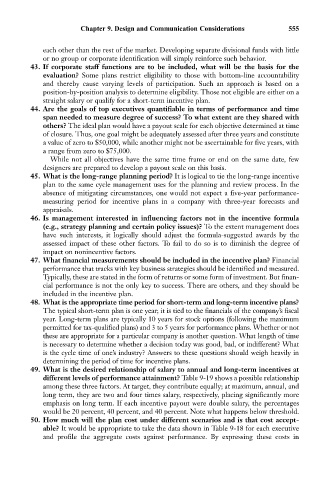Page 569 - Bruce Ellig - The Complete Guide to Executive Compensation (2007)
P. 569
Chapter 9. Design and Communication Considerations 555
each other than the rest of the market. Developing separate divisional funds with little
or no group or corporate identification will simply reinforce such behavior.
43. If corporate staff functions are to be included, what will be the basis for the
evaluation? Some plans restrict eligibility to those with bottom-line accountability
and thereby cause varying levels of participation. Such an approach is based on a
position-by-position analysis to determine eligibility. Those not eligible are either on a
straight salary or qualify for a short-term incentive plan.
44. Are the goals of top executives quantifiable in terms of performance and time
span needed to measure degree of success? To what extent are they shared with
others? The ideal plan would have a payout scale for each objective determined at time
of closure. Thus, one goal might be adequately assessed after three years and constitute
a value of zero to $50,000, while another might not be ascertainable for five years, with
a range from zero to $75,000.
While not all objectives have the same time frame or end on the same date, few
designers are prepared to develop a payout scale on this basis.
45. What is the long-range planning period? It is logical to tie the long-range incentive
plan to the same cycle management uses for the planning and review process. In the
absence of mitigating circumstances, one would not expect a five-year performance-
measuring period for incentive plans in a company with three-year forecasts and
appraisals.
46. Is management interested in influencing factors not in the incentive formula
(e.g., strategy planning and certain policy issues)? To the extent management does
have such interests, it logically should adjust the formula-suggested awards by the
assessed impact of these other factors. To fail to do so is to diminish the degree of
impact on nonincentive factors.
47. What financial measurements should be included in the incentive plan? Financial
performance that tracks with key business strategies should be identified and measured.
Typically, these are stated in the form of returns or some form of investment. But finan-
cial performance is not the only key to success. There are others, and they should be
included in the incentive plan.
48. What is the appropriate time period for short-term and long-term incentive plans?
The typical short-term plan is one year; it is tied to the financials of the company’s fiscal
year. Long-term plans are typically 10 years for stock options (following the maximum
permitted for tax-qualified plans) and 3 to 5 years for performance plans. Whether or not
these are appropriate for a particular company is another question. What length of time
is necessary to determine whether a decision today was good, bad, or indifferent? What
is the cycle time of one’s industry? Answers to these questions should weigh heavily in
determining the period of time for incentive plans.
49. What is the desired relationship of salary to annual and long-term incentives at
different levels of performance attainment? Table 9-19 shows a possible relationship
among these three factors. At target, they contribute equally; at maximum, annual, and
long term, they are two and four times salary, respectively, placing significantly more
emphasis on long term. If each incentive payout were double salary, the percentages
would be 20 percent, 40 percent, and 40 percent. Note what happens below threshold.
50. How much will the plan cost under different scenarios and is that cost accept-
able? It would be appropriate to take the data shown in Table 9-18 for each executive
and profile the aggregate costs against performance. By expressing these costs in

